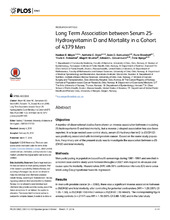Long Term Association between Serum 25-Hydroxyvitamin D and Mortality in a Cohort of 4379 Men
Meyer, Haakon E; Støer, Nathalie; Samuelsen, Sven Ove; Blomhoff, Rune; Robsahm, Trude Eid; Brustad, Magritt; Giovannucci, Edward L; Bjørge, Tone
Peer reviewed, Journal article
Published version

View/
Date
2016-03-17Metadata
Show full item recordCollections
Original version
https://doi.org/10.1371/ journal.pone.0151441Abstract
Objective A number of observational studies have shown an inverse association between circulating 25-hydroxyvitamin D and total mortality, but a reverse J-shaped association has also been reported. In a large nested case-control study, serum-25-hydroxyvitamin D (s-25(OH)D) was positively associated with incident prostate cancer. Based on the same study population, the primary aim of the present study was to investigate the association between s-25 (OH)D and total mortality. Methods Men participating in population based health screenings during 1981–1991 and enrolled in a nested case-control study were followed throughout 2007 with respect to all-cause and cause-specific mortality. Hazard ratios (HR) with 95% confidence intervals (CI) were calculated using Cox proportional hazards regression. Results In men with prostate cancer (n = 2282), there was a significant inverse association between s-25(OH)D and total mortality after controlling for potential confounders (HR = 1.25 (95% CI 1.05–1.50), s-25(OH)D < 50 nmol/l versus s-25(OH)D > 50 nmol/l). The corresponding figure among controls (n = 2147) was HR = 1.15 (95% CI 0.88–1.50) and in the total study.population HR = 1.19 (95% CI 1.03–1.38). For cause-specific deaths, we found no significant associations. Conclusions In this study population, s-25(OH)D was inversely associated with total mortality during more than two decades of follow-up, despite, as previous reported, high s-25(OH)D was associated with increased risk of prostate cancer.
